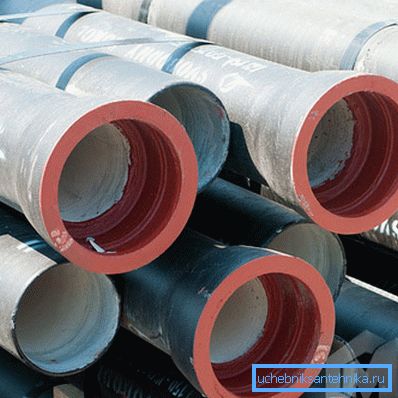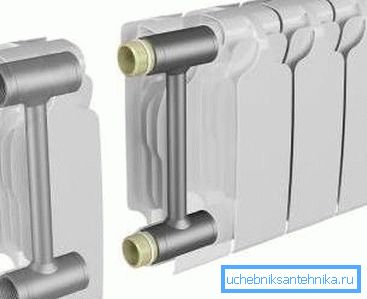Selection of heating radiators: selection criteria dictated
We will try to tell you how to choose a radiator. We will make a reservation that this will be just a general overview, not a specific indication, since this is a fairly individual matter.
Nevertheless, you yourself can determine what you choose, if you substitute the features of the technical conditions of your home under certain criteria. In addition, it will be a question not only of the materials from which the heating devices are made, but also of their power and calculation, but a thematic video clip will consolidate your knowledge.

Radiators. Selection
Note. When choosing a radiator for a house or apartment, you need to consider several criteria. First, it is its working pressure and the estimated pressure in the system, secondly, the material of manufacture for compatibility with the coolant, thirdly, its value in relation to the volume of the room and, fourthly, the aesthetic appearance.
Cast iron

You see on the top photo a painfully familiar, especially to the older generation, who managed to live in the USSR, a cast-iron battery, the production of which has not stopped until now, besides, the contours of such devices fully justify themselves. The main advantage of such a device can be called its compatibility with any coolant, and the strength of gray iron does not cause complaints.
In residential buildings of the era of Khrushchev, there are still radiators in some apartments that were installed during the construction of the house! This may seem incredible, but this is true - my neighbors have not repaired heating for 52 years (the house was built in 1963) and during this time leaks were only on pipes!
Of course, this does not mean that the cast iron should last for so long - there are many cases when leaks occur in 10-20 years, although the instruction usually guarantees a 30-year service life. But such failures can occur not because of the poor condition of the cast iron, but from poor-quality assembly of sections - as a rule, the material itself does not arise.
The accompanying documents indicate the working pressure - depending on the wall thickness it can be 9-12 atmospheres, although the pressure test (test) reaches 14-16 atmospheres, the instruments can be single-channel and two-channel.
Cast iron has one distinctive feature - it retains heat for a long time, which is very convenient for centralized heating, but not quite suitable for autonomy, since it is also not easy to heat a thick wall. In addition, in such sections there is a very high water consumption, which, again, requires energy resources. The weight of one section, depending on the size of the device can be from 3.5 kg to 7.1 kg.
Steel

The steel panel radiators of heating are probably the lowest price of all similar devices, but this does not at all indicate the failure of the structure - just the material and production costs much less.
If we are talking about panels, then they can be one, two or three pieces, but each consists of two profiles, which have stamped channels for the liquid and are welded together by roller welding. Such parts are interconnected by connections, as is seen in the upper image.
Depending on how many panels the device consists of, additional elements accompany it to optimize air convection.

Explanations for the photo:
- 10 - single panel, without convector and cladding;
- 11 - single row without grate, with convector;
- 20 - double row, with air convex grille, without convector;
- 21 - double row, convective fins, casing;
- 22 - double row, two convective fins, casing;
- 30 - three-row, convective finning is absent, crib on top;
- 33 - three-row, three convective fins; casing
Note. The efficiency of heat transfer of such radiators, which are presented above, depends on the ability to more or less convect air. Types No. 10 and No. 11 give off thermal energy only from the wall; therefore, they are the weakest.
Because of the cheapness of such devices, their small size and ease of installation, they are given preference in the private sector. The working pressure of the devices described above, depending on the manufacturer, is from 8 to 10 atmospheres.

The tubular devices made of steel are much more expensive and more complex in design - they look very similar to the cast iron radiators that are familiar to many, but they heat up much faster, not inferior to the working pressure - at least 12 atmospheres and 16 atmospheres at pressure testing. The main problem of such heaters is their very high cost - the domestic device costs more than imported bimetallic.
Aluminum

The main advantage of aluminum as a metal in this case is its high heat transfer and low weight, but not everything is so simple - they are made from alloys. One of the production methods is the casting method, where 12% of silicon is added - an alloy called silumin.
Such a device is provided with sufficiently thick walls, and it is able to withstand a working pressure from 6 to 16 atmospheres.
Another method is extrusion, that is, separate, vertical parts of the device are made by extruding aluminum, but still, the collector is cast from the same silumin, although in some cases it is also produced by extrusion. After that, all parts are pressed together.
But, both cast and extrusion radiators are not of particularly high quality - they can flow at the joints and the heat from them is not evenly distributed.
A completely different line is anodized batteries, for the manufacture of which purified aluminum of the highest quality is used - anodic oxidation is made during the manufacturing process, which changes the structure of the metal, after which it is not afraid of corrosion.
Couplings are used to connect the sections, and their front side is very smooth, and the heat output is uniform and high. In addition, there is a very high working pressure and, depending on the modification, it can reach 50-70 atmospheres, but the cost of such heaters is very high.
Note. Aluminum devices (except for anode ones) should be used only in independent heating systems. In addition, anti-corrosion additives must be added to the coolant.
Bimetal

Immediately it should be said that there is bimetal and polibimetal, which affects the technical characteristics of radiators. Everyone, of course, understands that the concept itself implies the connection of two metals at the level of adhesion, without melting.
The welded steel core under high pressure is poured with aluminum - as a result, the coolant contacts only the steel (the danger of corrosion disappears), and the aluminum shirt serves as an excellent conductor of heat, creating, in addition, a good aesthetic appearance.
Also, the core in some cases can be made of copper - the selection of a heating radiator for autonomous systems with the addition of antifreeze to the coolant corrodes steel. This option is the most optimal solution.
In polibimetallic radiators, the core consists of two metals - steel and aluminum, where vertical channels are made of steel, and horizontal - aluminum. This combination leads to an increase in heat transfer, but, at the same time, alkalis in hot water (especially in centralized heating) will cause aluminum corrosion. In addition, the different physical properties of Al and Fe when heated can lead to channel displacement.
Bimetallic heaters can be sectional or monolithic, but they clearly differ in technical indicators:
| Type of radiator | Lifetime | Operating pressure | Thermal power |
| Monolithic | 50 years | 100 bar | 100-200W |
| Sectional | 20-25 years | 20-35 bar | 100-200W |
comparison table
Such radiators are suitable for both autonomous and centralized heating, but in the latter case (especially in high-rise buildings) this is a real panacea, where the pressure in the system can sometimes reach 9-12 atmospheres, and the water is not cleaned there and carries are various active elements dangerous to non-ferrous metals.
Power calculation

- Now let's see how to calculate the necessary power of radiators over the floor space, if the ceilings in it do not exceed the standard height of 240-260 cm and here for one square meter according to SNiP 2.04.05-91 * you need 100W of thermal energy. For example, let's take a room of 3.55.5 m, which means that we will need 3.5 * 5.5 * 100 = 1925W or 1.925kW and we need to choose a heating device for this value.
- If you choose a panel radiator, then you just need to pay attention to its power and take one or two devices so that the amount is at least 2 kW (always rounded up), but in the case of sections, you just need to calculate their total power. Take, for example, bimetal, where the average power section reaches 170W or 0.17kW, and calculate the number of pieces for the same area. 1,925 / 0,17? 11,35, then you will need 12 sections.
- And how to choose a heating radiator, if a room with high ceilings - here, according to the same SNiP, the norm is 41W / m3. Take a room with the same area, but with 3m ceilings, it means that the required power will be 3.5 * 5.5 * 3 * 41 = 2367.25W, then 2367.25 / 170? 13.9, which means that you will need 14 sections, which can be assembled in one or two devices.
Conclusion
If you want to install the heating in your house with your own hands, then when choosing and calculating the power of radiators you should always take into account the heat loss that occurs with a large number of windows, from drafts, with frequent ventilation, and so on. Therefore, depending on the possibility of heat loss, always add to the received power 100-200W or just one section. Successes!